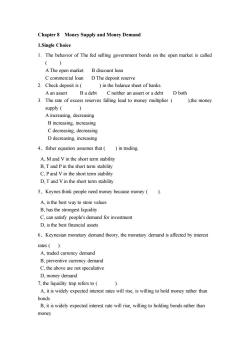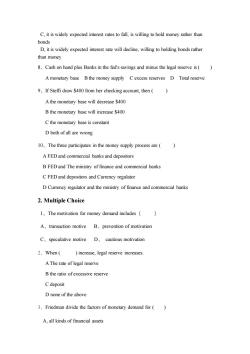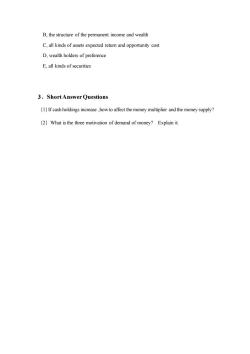同济大学:《货币金融学》课程教学资源(试卷习题)Chapter 8 Money Supply and Money Demand

Chapter 8 Money Supply and Money Demand 1.Single Choice 1.The behavior of The fed selling government bonds on the open market is called A The open market B discount loan C commercial loan D The deposit reserve 2.Check deposit is in the balance sheet of banks. A an assert B a debt C neither an assert or a debt D both 3.The rate of excess reserves falling lead to money multiplier ),the money supply A increasing,decreasing B increasing,increasing C decreasing,decreasing D decreasing,increasing 4、fisher equation assumes that()in trading A,M and V in the short term stability B,T and P in the short term stability C,P and V in the short term stability D,T and V in the short term stability 5,Keynes think people need money because money () A,is the best way to store values B,has the strongest liquidity C,can satisfy people's demand for investment D,is the best financial assets 6.Keynesian monetary demand theory,the monetary demand is affected by interest rates () A,traded currency demand B,preventive currency demand C,the above are not speculative D,money demand 7,the liquidity trap refers to A,it is widely expected interest rates will rise,is willing to hold money rather than bonds B,it is widely expected interest rate will rise,willing to holding bonds rather than money
Chapter 8 Money Supply and Money Demand 1.Single Choice 1. The behavior of The fed selling government bonds on the open market is called ( ) A The open market B discount loan C commercial loan D The deposit reserve 2. Check deposit is ( ) in the balance sheet of banks. A an assert B a debt C neither an assert or a debt D both 3. The rate of excess reserves falling lead to money multiplier ( ),the money supply ( ) A increasing, decreasing B increasing, increasing C decreasing, decreasing D decreasing, increasing 4、fisher equation assumes that ( ) in trading. A, M and V in the short term stability B, T and P in the short term stability C, P and V in the short term stability D, T and V in the short term stability 5、Keynes think people need money because money ( ). A, is the best way to store values B, has the strongest liquidity C, can satisfy people's demand for investment D, is the best financial assets 6、Keynesian monetary demand theory, the monetary demand is affected by interest rates ( ). A, traded currency demand B, preventive currency demand C, the above are not speculative D, money demand 7, the liquidity trap refers to ( ). A, it is widely expected interest rates will rise, is willing to hold money rather than bonds B, it is widely expected interest rate will rise, willing to holding bonds rather than money

C,it is widely expected interest rates to fall,is willing to hold money rather than bonds D,it is widely expected interest rate will decline,willing to holding bonds rather than money 8.Cash on hand plus Banks in the fed's savings and minus the legal reserve is() A monetary base B the money supply C excess reserves D Total reserve 9.If Steffi draw $400 from her checking account,then ( A the monetary base will decrease $400 B the monetary base will increase $400 C the monetary base is constant D both of all are wrong 10.The three participates in the money supply process are ( A FED and commercial banks and depositors B FED and The ministry of finance and commercial banks C FED and depositors and Currency regulator D Currency regulator and the ministry of finance and commercial banks 2.Multiple Choice l、The motivation for money demand includes( A、transaction motive B.prevention of motivation C、speculative motive D、cautious motivation 2、When( )increase,legal reserve increases. A The rate of legal reserve B the ratio of excessive reserve C deposit D none of the above 3.Friedman divide the factors of monetary demand for ( A,all kinds of financial assets
C, it is widely expected interest rates to fall, is willing to hold money rather than bonds D, it is widely expected interest rate will decline, willing to holding bonds rather than money 8、Cash on hand plus Banks in the fed's savings and minus the legal reserve is ( ) A monetary base B the money supply C excess reserves D Total reserve 9、If Steffi draw $400 from her checking account, then ( ) A the monetary base will decrease $400 B the monetary base will increase $400 C the monetary base is constant D both of all are wrong 10、The three participates in the money supply process are ( ) A FED and commercial banks and depositors B FED and The ministry of finance and commercial banks C FED and depositors and Currency regulator D Currency regulator and the ministry of finance and commercial banks 2. Multiple Choice 1、The motivation for money demand includes( ) A、transaction motive B、prevention of motivation C、speculative motive D、 cautious motivation 2、When ( ) increase, legal reserve increases. A The rate of legal reserve B the ratio of excessive reserve C deposit D none of the above 3、Friedman divide the factors of monetary demand for ( ) A, all kinds of financial assets

B,the structure of the permanent income and wealth C,all kinds of assets expected return and opportunity cost D,wealth holders of preference E,all kinds of securities 3,ShortAnswer Questions (1)If cash holdings increase how to affect the money multiplier and the money supply? (2)What is the three motivation of demand of money?Explain it
B, the structure of the permanent income and wealth C, all kinds of assets expected return and opportunity cost D, wealth holders of preference E, all kinds of securities 3、Short Answer Questions (1)If cash holdings increase ,how to affect the money multiplier and the money supply? (2)What is the three motivation of demand of money? Explain it
按次数下载不扣除下载券;
注册用户24小时内重复下载只扣除一次;
顺序:VIP每日次数-->可用次数-->下载券;
- 同济大学:《货币金融学》课程教学资源(试卷习题)Chapter 7 Financial Markets.docx
- 同济大学:《货币金融学》课程教学资源(试卷习题)Chapter 6 Central Banks.docx
- 同济大学:《货币金融学》课程教学资源(试卷习题)Chapter 5 Commercial Banks.docx
- 同济大学:《货币金融学》课程教学资源(试卷习题)Chapter 4 The Economics of Financial Intermediary.docx
- 同济大学:《货币金融学》课程教学资源(试卷习题)Chapter 3 Interest and Interest Rate.docx
- 同济大学:《货币金融学》课程教学资源(试卷习题)Chapter 2 Credit and Financial Instruments.docx
- 同济大学:《货币金融学》课程教学资源(试卷习题)Chapter 1 Money and Monetary System.docx
- 同济大学:《货币金融学》课程教学资源(大纲教案)教学大纲 The Economics of Money and Banking.pdf
- 吉林大学:《财政学》课程教学资源(试卷习题)远程教育考试样卷(无答案).doc
- 吉林大学:《经济法》课程电子教案(PPT教学课件,共十三章,授课对象:远程教育,授课教师:孙凤英).ppt
- 《财务管理》课程教学资源(专项报告)南宁市宾阳县生猪现代农业产业园实施方案(简版).pdf
- 《财务管理》课程教学资源(专项报告)存栏1120头商品猪养殖小区可行性研究报告(简版).pdf
- 《财务管理》课程教学资源(专项报告)存栏2000头祖代原种猪场可行性研究报告(简版).pdf
- 《财务管理》课程教学资源(专项报告)存栏3000头曾祖代原种猪场环保生态养殖综合开发项目可研报告(简版).pdf
- 《财务管理》课程教学资源(专项报告)存栏5000头基础母猪现代化生猪养殖场可行性研究报告(简版).pdf
- 《财务管理》课程教学资源(专项报告)山西灵空山国家级自然保护区2016年林业国家级自然保护区补助资金建设项目可行性研究报告(简版).pdf
- 《财务管理》课程教学资源(专项报告)森林康养度假建设项目可行性研究报告(简版).pdf
- 山西农业大学:《财务管理》课程教学资源(试卷习题)财务管理期末考试模拟题三及答案.pdf
- 山西农业大学:《财务管理》课程教学资源(试卷习题)财务管理期末考试模拟题二及答案.pdf
- 山西农业大学:《财务管理》课程教学资源(试卷习题)财务管理期末考试模拟题一及答案.pdf
- 同济大学:《货币金融学》课程教学资源(试卷习题)Chapter 9 Money and Inflation.docx
- 同济大学:《货币金融学》课程教学资源(试卷习题)Answers for Test Sample(参考答案)Chapter 1-10.docx
- 同济大学:《货币金融学》课程电子教案(课件讲稿)Chapter 1 Introduction(负责人:郭英).pdf
- 同济大学:《货币金融学》课程电子教案(课件讲稿)Chapter 2 Money and Monetary System.pdf
- 同济大学:《货币金融学》课程电子教案(课件讲稿)Chapter 3 Credit and Financial Instrument.pdf
- 同济大学:《货币金融学》课程电子教案(课件讲稿)Chapter 4 Interest and Interest Rate.pdf
- 同济大学:《货币金融学》课程电子教案(课件讲稿)Chapter 5 Financial Institutions.pdf
- 同济大学:《货币金融学》课程电子教案(课件讲稿)Chapter 6 Commercial Banks.pdf
- 同济大学:《货币金融学》课程电子教案(课件讲稿)Chapter 7 Central Banks.pdf
- 同济大学:《货币金融学》课程电子教案(课件讲稿)Chapter 8 Financial Markets.pdf
- 同济大学:《货币金融学》课程电子教案(课件讲稿)Chapter 10 Monetary Policy.pdf
- 同济大学:《货币金融学》课程电子教案(课件讲稿)Chapter 9 Money Demand and Money Supply.pdf
- 同济大学:《货币金融学》课程电子教案(课件讲稿)Chapter 11 Inflation and Deflation.pdf
- 吉林大学:《会计学》课程电子教案(PPT课件)第一章 绪论(负责人:孙烨).ppt
- 吉林大学:《会计学》课程电子教案(PPT课件)第二章 帐户与复式记帐.ppt
- 吉林大学:《会计学》课程电子教案(PPT课件)第三章 分录与记帐.ppt
- 吉林大学:《会计学》课程电子教案(PPT课件)第四章 试算与调整.ppt
- 吉林大学:《会计学》课程电子教案(PPT课件)第十章 无形资产与其他资产.ppt
- 吉林大学:《会计学》课程电子教案(PPT课件)第十一章 负债.ppt
- 吉林大学:《会计学》课程电子教案(PPT课件)第十二章 所有者权益.ppt
